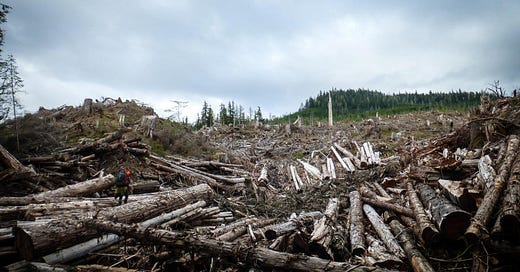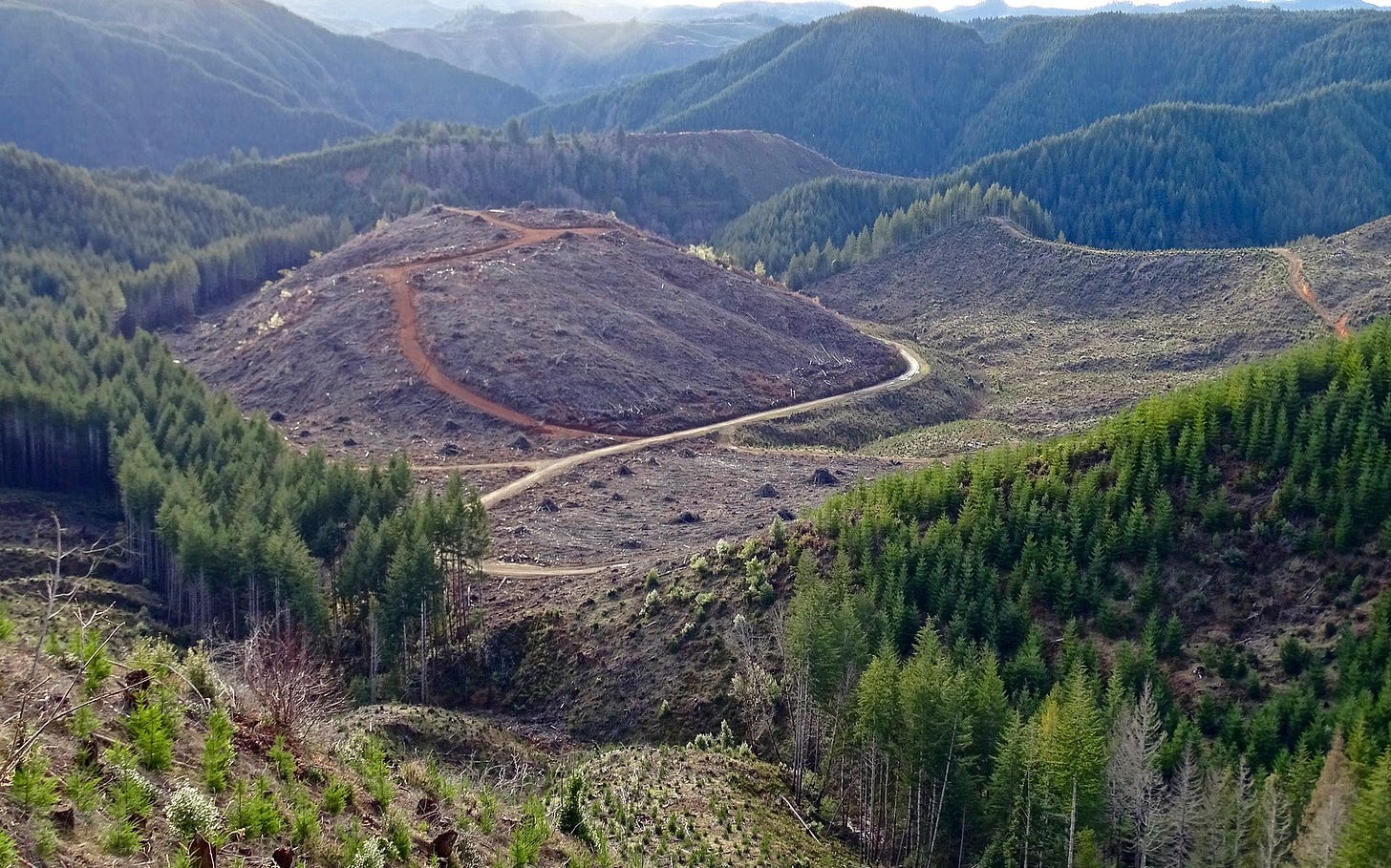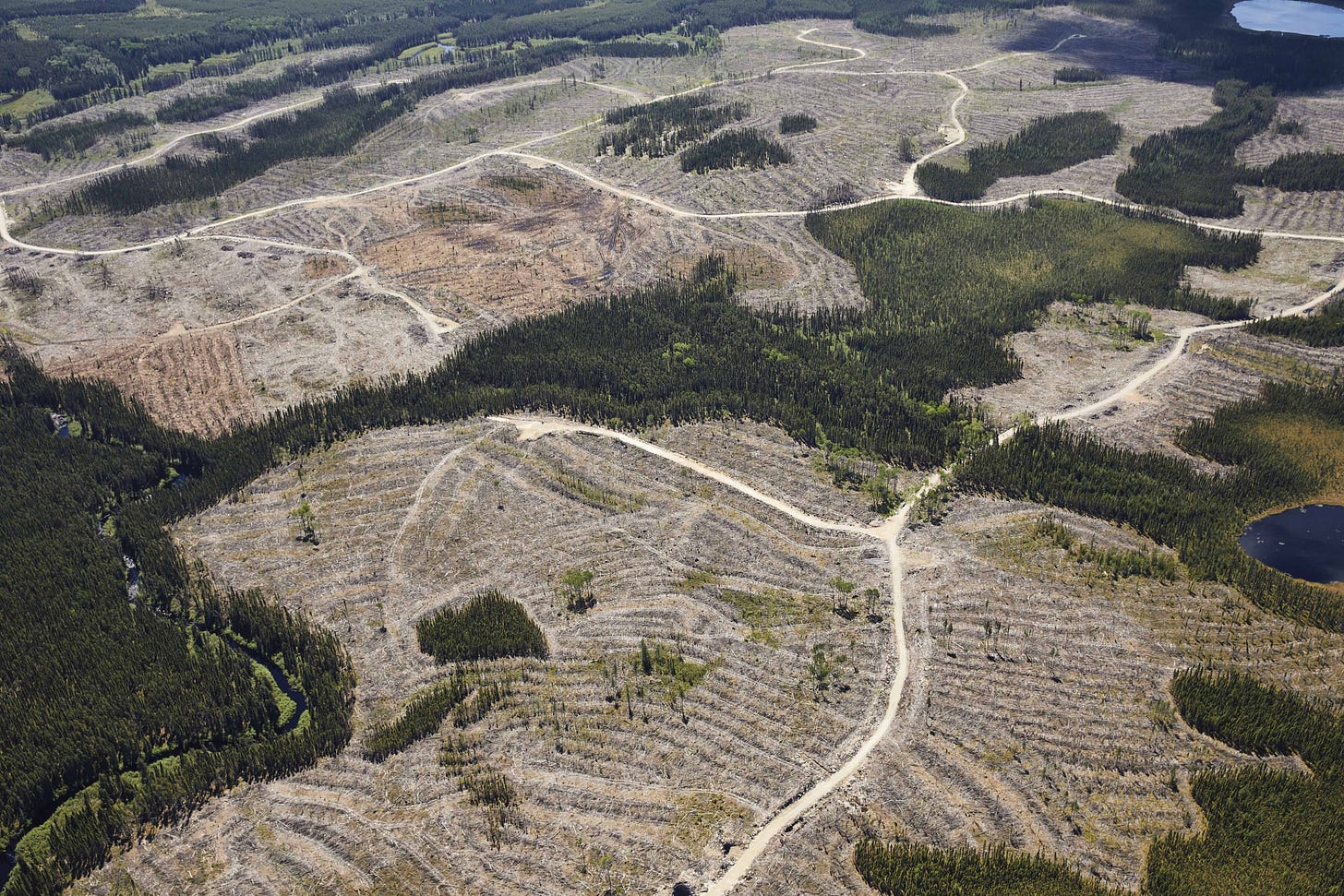There are different reasons for clearcutting (also termed clear-felling): There’s the straight-forward collection of timber, there’s the razing of forests for ranching, grazing, agriculture and disease mitigation - and then there are also reforestation efforts. Whatever the reasons, even before knowing the first thing about clearcutting, wouldn’t the destruction of entire habitats (or microhabitats) seem like a terrible idea to begin with?
To raze - or to selectively extract
In Switzerland, where I get to reside, I never see clearcutting - the reason for that is simple: it is prohibited (as it is in most European countries). Mind you, as with all laws, there are loopholes and not all’s as clearcut, pardon the pun, as it would seem (in this 2021 article, my friend Lucie Wuetrich elucidates).
Across Switzerland’s many ‘managed forests’, the taking of timber happens by selective extraction. Machines (sometimes monster-sized) drive along a forest road, then veer off for short stretches straight into the woodland. From there the big machines efficiently take ten or twenty of the previously marked trees, fell them, strip them and stack them.
While these acts of extraction no doubt represent terrifying moments for woodland creatures (and a massive disruptive force to the soil), and while some lives and homes are destroyed, the overall habitat remains.
Because there continues to be forest in every direction, many woodland creatures can get out of the way and resettle, and plants and mushrooms will continue to be networked through soil that will recover before long. But when you clearcut large swaths, entire habitats (and their networks) are destroyed.

Arguments for clearcutting
The biggest argument for clearcutting is efficiency, pure and simple. It’s highly cost-effective, leaving timber companies and landowners with more profit. Metaphorically, clearcutting is like harvesting a field of corn, you mow it all down in one go. Done. Are their other reasons that stand in favor for clearcutting? Let’s take a look at some that are put forward:
Promoting regeneration and biodiversity: One of the pros mentioned highlights that clearcutting is good for nature in that sunlight now penetrates the forest floor (the ex-forest floor, that is), thus allowing for the growth of new plants. Clearcutting is also said to increase species diversity and new habitat creation for wildlife species, “fostering a dynamic ecosystem”. Frankly, if something sounds an awful lot like spin, it probably is (and this argument definitely is).
Clearcutting as pest and disease control: Here the argument is that clearcutting helps prevent the spread of pathogens and pests to other areas of forest by removing infected trees. This, however, isn’t an argument for clearcutting, it is simply a necessary means when confronted with infected trees. Then, obviously, those trees will be removed. Quite different from clearcutting, these are (should be) surgical operations when and if a disease is spotted. Such necessary logging is called salvage felling.
Clearcutting a boon for economic development: Industries always rush to confirm their importance in this way. Here they say that “clearcutting operations create jobs in logging, transportation, and millwork, supporting local economies.” Like every other industry, they always argue the status quo. This then is a false proposition. Clearcutting is unimportant, forestry overall is. And by going about the timber business in non-clearcutting ways, all of the work would still happen, all the people and more would still be needed.
Fire prevention: Obviously, if you clearcut, you create firebreaks and there’s less fuel for a wildfire to rage on with. This is listed as one of the advantage of clearcutting … is it? Wildfires will only become more extreme due to climate change-induced more extreme weather conditions. Wildfires won’t just continue to happen, but will increase in number and ferocity as recent examples have shown. Firebreaks are an important measure - but it doesn’t gel to make this an argument for the efficient razing (profit-making) of timber businesses. Clearcutting, I’ve read, actually leads to more same-age forest patches that burn hotter and faster than diverse forests would. It also leaves the soil far drier (water isn’t kept by trees and roots and simply runs off), actually helping fires more than hindering them.
Arguments against clearcutting
The arguments against clearcutting are pretty overwhelming, frankly. There’s all of those arguments on one side, and then there’s the economic system and human nature on the other. Clearcutting clearly represents a prime example of man over nature, of nature existing solely for us to use as we see fit.
There are better ways.
Humanity needs timber and humanity can have timber - but the current economic system of streamlining everything to become ever more cost-effective clearly is not in the best interests of a healthy, sustainable, biodiversity-rich environment. The better ways will be more costly in that they are less efficient. No more razing entire woods means more time-consuming efforts to extract timber, and leaving the forest in place, alive, able to resiliently bounce back after extractions. This is possible and this is happening. The only reason why clearcutting continues to be a thing is, again, efficiency, it’s all about profit and profit margins.
As for arguments against clearcutting … where to begin:
it destroys entire ecosystems for both flora and fauna;
it disrupts ecological balance at a disastrous scale;
it results in decline (even regional extinction) of species;
it exposes the soil to erosion and degradation (as rainfall washes away topsoil);
it affects surrounding riparian ecosystems;
it negatively impacts climate, particularly also the local microclimate;
it can increase flooding;
it releases a lot of carbon dioxide;
it destroys carbon sinks;
it negatively impacts ecosystem services (water purification, soil quality, nutrient cycling) of surrounding environments for local communities;
it gives room for invasive species to take over;
it makes remaining trees more vulnerable “to diseases and pests, as they lose the protection and resilience provided by a diverse forest ecosystem.”
“Alternatives to clear-fell are available and are gaining traction. Diversifying the types of tree planted, encouraging regeneration, normalising forest production, maintaining mixtures, using continuous cover and quality over quantity should be our aim.” (Forestry Researcher and forest manager James Andrew Reilly 👉 Is clear-felling past its sell-by date?)
In conclusion
It was no doubt clear from the start of this article that I am opposed to clearcutting. It more gut feel and less informed opposition. Now, after learning more about it, I’d opt against clearcutting under any circumstances - even with the important removal of sitka spruce plantations in Scotland’s rewilding landscapes.
There, too, I think that keeping a habitat intact is the better, the more gentle, way to go. Razing it all and then reforesting is more akin to revolution - I’d opt for evolution - it’s slower change, it’s messier, and it’s certainly less efficient for timber companies. But keeping habitats and their networks in tact should take higher priority.
It think that we must be ready to accept the higher cost that comes with lower efficiency. Companies would be just as necessary as always, there’d probably be even more employment - but flora and fauna, the soil, the ecosystems, would have stronger standing. They’d be given the the chance to thrive.
Why destroy if we can choose to occasionally disrupt instead? Yes, efficiency, I get that … but I think we have to eventually get passed that tired argument in favor of a resilient natural environment.
After all I’ve seen I think I can say that no clearcutting is done out of necessity, it is always done out of expediency. Quora listed clearcutting pros and cons - and it comes to the same conclusion that, I think, we should all come to:
“While clearcutting can provide short-term economic and ecological benefits, its long-term impacts on biodiversity, soil health, and ecosystem stability can be significant drawbacks. Sustainable forest management practices often seek to balance the benefits of timber harvesting with the need to maintain healthy, diverse ecosystems.”
That’s it from me for now - happy weekend to ya.
Cheers,
If you enjoy the Rewilder Weekly …
… consider supporting my work. Your subscription will help generate the funds needed to realize a unique rewilding book I’m working on. And, of course, that subscription also ensures that the Rewilder Weekly will always keep going for those who cannot afford to pay. A thousand thanks!












This was such a sobering read. The phrase “destructive efficiency” really stuck with me. It captures so well how modern forestry can become a machine of removal, not renewal. Here in the UK, we’re seeing echoes of this too with large-scale clear-felling justified under the guise of “management,” but with little thought to soil health, biodiversity, or the cultural landscapes left behind.
That said, I’m heartened by the rise of alternative approaches like continuous cover forestry, which keeps the canopy intact while harvesting selectively; or native woodland creation schemes that aim to restore complex, resilient ecosystems rather than uniform plantations. Projects like the restoration of temperate rainforests in the West of Scotland, or the work being done in the South West to bring back diverse coppice systems, give me hope that forestry can be something more than extraction — that it can be about relationship, recovery, and time.
Thanks again for shining a light on this. 🌳